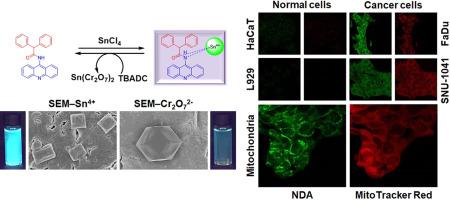Journal of Hazardous Materials ( IF 12.2 ) Pub Date : 2021-06-16 , DOI: 10.1016/j.jhazmat.2021.126409 Palanisamy Ravichandiran 1 , D S Prabakaran 2 , Nikhil Maroli 3 , Ae Rhan Kim 4 , Byung-Hyun Park 5 , Myung-Kwan Han 6 , Thiyagarajan Ramesh 7 , Samuel Ponpandian 8 , Dong Jin Yoo 1

|
The goal of the present work was to fabricate a new low-cost, easy-to-prepare, dual-channel fluorescence chemosensor comprised of acridine-diphenylacetyl moieties (NDA) to enable remarkable Sn4+ detection in water and biological medium. The resulting NDA–Sn4+ complex was utilized for the distinguished identification of Cr2O72- ions from other anions and biomolecules. These investigations involve the absorption, fluorescence, and electrochemical methods for the detection of Sn4+ and Cr2O72- ions in pure water. The mechanism for NDA-mediated Sn4+ detection was experimentally determined by FT-IR, NMR titrations, mass (ESI) analyses, and DFT calculations. The obtained results indicate that the NDA chemosensor possessed excellent performance characteristics including good water solubility and compatibility, quick response time (less than 10 s), high sensitivity (Sn4+ = 0.268 μM and Cr2O72- = 0.160 μM), and selectivity against coexisting metals, anions, amino acids, and peptides. The chemosensor NDA induced negligible toxicity in live cells and was successfully utilized as a biomarker for the tracking of Sn4+ in human normal and cancer cells. More importantly, NDA demonstrates distinguished recognition of Sn4+ in human cancer cells rather than in normal live cells. Additionally, NDA was shown to act as a mitochondria-targeted probe in FaDu cells.
中文翻译:

线粒体靶向吖啶双通道荧光化学传感器检测水中Sn4+和Cr2O72-离子及其在癌细胞鉴别检测中的应用
目前工作的目标是制造一种新的低成本、易于制备、双通道荧光化学传感器,由吖啶-二苯乙酰基部分 ( NDA ) 组成,以实现水和生物介质中显着的 Sn 4+检测。所得的NDA –Sn 4+复合物用于从其他阴离子和生物分子中区分 Cr 2 O 7 2-离子。这些研究涉及用于检测纯水中 Sn 4+和 Cr 2 O 7 2-离子的吸收、荧光和电化学方法。NDA介导的Sn的机制4+检测通过 FT-IR、NMR 滴定、质量 (ESI) 分析和 DFT 计算通过实验确定。结果表明,NDA化学传感器具有良好的水溶性和相容性、响应时间快(小于10 s)、灵敏度高(Sn 4+ = 0.268 μM和Cr 2 O 7 2- = 0.160 μM)等优异性能特点,以及对共存金属、阴离子、氨基酸和肽的选择性。化学传感器NDA在活细胞中诱导的毒性可忽略不计,并成功用作跟踪人类正常细胞和癌细胞中 Sn 4+的生物标志物。更重要的是,保密协议证明了对人类癌细胞而不是正常活细胞中的 Sn 4+ 的显着识别。此外,NDA被证明在 FaDu 细胞中充当线粒体靶向探针。











































 京公网安备 11010802027423号
京公网安备 11010802027423号